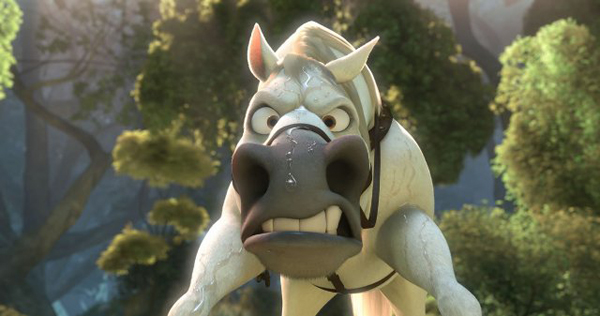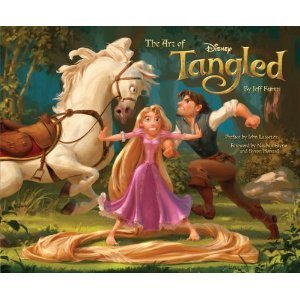
COMMENTARY

A Horse of a Different Color
Not long before I saw Tangled, the new Disney CGI feature, a friend wrote to me to express his disappointment that "for the most part the human characters moved so naturally that ... I felt like I was watching a live-action movie." When I saw Tangled, I understood what he meant, particularly when I watched a quiet scene between Rapunzel and the outlaw Flynn Rider. That scene didn't just resemble live action, it felt exactly like live action, thanks to the complete naturalness of the characters' movements.
Far from being disappointed in the animation, as my friend was, I was thrilled by it. A great deal of CGI animation has more or less successfully aped live action, especially its surface textures, but the exact equivalence I saw in parts of Tangled has never been achieved before, to my knowledge. I would have said that it couldn't be done, but I would have been wrong.
That perfectly natural CGI animation was thrilling to me because it was the first such animation that seemed to be in complete harmony with the persistent impulse behind all art forms: mimesis, the imitation of life. Art and life are very different, but art in the hands of its greatest practitioners has a vital connection with life: the artist expresses himself most strongly not through invention, but through his choice and arrangement from the boundless material that life offers to him. There may be detours along the way—the twentieth century was full of them—but it always comes back to that.
Where CGI is concerned, it seems to me that a complete naturalness in the characters' movements, like that in parts of Tangled, does not limit the animators to a deadening literalness. Instead, it creates the potential for more subtle and expressive animation of a distinctly non-literal kind, just as the Disney animators' growing mastery of hand-drawn animation in the 1930s meant that cartoon characters like the Seven Dwarfs could be more insistently present on the screen than characters that were drawn with superficially greater realism.
There is in Tangled one character that exemplifies the potential of a more advanced kind of CGI: the horse Maximus. He is a furiously eccentric character, as much bloodhound as horse, commanding the screen whenever he appears on it in his manic pursuit of Flynn Rider. The Disney character designer Jin Kim described him: "The horse has a big, thick neck, and powerful shoulders, and then these great expressions. ... This horse is based on the Andalusian, that Spanish breed. That horse has a kind of a unique posture, very upright, a straight neck, like a chess piece." Maximus is unmistakably a cartoon character, but one designed and animated with a subtlety and precision alien to those animators and fans who confuse "cartoon" with "broad and sloppy"—the sad cases who, like old women fingering their rosary beads, murmur "cartoony, cartoony" as they offer prayers to Saint John Kricfalusi.
Remarkably, and wonderfully, we're given no tedious "back story" explaining how Maximus came to be so strange and compelling; he is who he is. He is in wonderful contrast to Mittens, the cat character in the wretched Bolt, Disney's previous CGI feature, who lays out her sad life story in tedious detail. I was surprised by the lack of anything comparable for Maximus, because so many of the key people on Tangled held comparable positions on Bolt. Byron Howard co-directed the earlier film; his co-director on Tangled was Nathan Greno, who was credited as Bolt's story supervisor. It was those questionable credentials that almost led me to skip Tangled entirely.
I'm glad I didn't, but Tangled has problems that make me wonder how much of what's good about it is there more by accident than by design. Too often the story works against the sense of reality that the animation establishes. For example: Flynn Rider is knocked unconscious not once but three times by a skillet-wielding Rapunzel, and in one instance he is out for what seems like a very long time. This is very ordinary cartoon business, but more to the point, if a character who otherwise seems as real as Flynn Rider were the target of a blow with a heavy skillet, he would most likely be killed, his skull crushed; or, if the blow were light enough not to cause any real damage, he would be no more than dazed. Certainly Rapunzel's attacks could be presented in a way that makes Flynn's survival not just acceptable but funny, but that's not done here; I don't detect any sign that anyone involved with the film thought there might be a problem. It's lapses of exactly this sort that make it so difficult to regard an animated film as other than kid stuff, and Tangled has more than a few of them.
 Did the directors and their superior, John Lasseter, understand or value the tool that their highly skilled (and essentially anonymous) animators gave to them? I have to doubt it. Lasseter's Pixar features have conspicuously shunned the challenge of animating real-seeming human characters, in favor of toys and cars and the like. There is, moreover, the evidence of Jeff Kurtti's new tie-in book The Art of Tangled, which emphasizes how hard the Disney artists worked to create a fairy-tale atmosphere recalling early Disney features like Pinocchio and Cinderella. They succeeded only too well, although the strongest echoes are of Beauty and the Beast, itself a partly successful effort to recapture past glories.
Did the directors and their superior, John Lasseter, understand or value the tool that their highly skilled (and essentially anonymous) animators gave to them? I have to doubt it. Lasseter's Pixar features have conspicuously shunned the challenge of animating real-seeming human characters, in favor of toys and cars and the like. There is, moreover, the evidence of Jeff Kurtti's new tie-in book The Art of Tangled, which emphasizes how hard the Disney artists worked to create a fairy-tale atmosphere recalling early Disney features like Pinocchio and Cinderella. They succeeded only too well, although the strongest echoes are of Beauty and the Beast, itself a partly successful effort to recapture past glories.
Glen Keane, whose animation of the Beast was the best thing about the earlier film, pushed for years to have the story of Rapunzel made as a fairy-tale feature, and he is credited as one of Tangled's "executive producers." Many of his warm, elegant drawings are spotted throughout Kurtti's book, but it's in the four pages devoted to Maximus that those drawings are most revealing. Keane's drawings are juxtaposed with drawings of the horse by Jin Kim, who was ultimately responsible for the character's design. Kurtti quotes Kim as saying: "The drawing wasn't that much of a problem because Glen had already done beautiful drawings, beautiful designs. It remains close to Glen's drawings. I didn't do too much to change it." But he did, actually. Keane's drawings are indeed beautiful, but set alongside Kim's, they seem soft and unfocused. It's in Kim's character designs, not Keane's, that the horse who ultimately commanded the screen is most clearly visible.
Tangled remains one of the best Disney or Pixar features of recent years. But like The Princess and the Frog, its hand-drawn predecessor, it invites admiration less for the vision of its directors and producers than for the excellent contributions by artists in less exalted positions. Such people should be working on films worthy of their talents.
[Posted January 7, 2011]